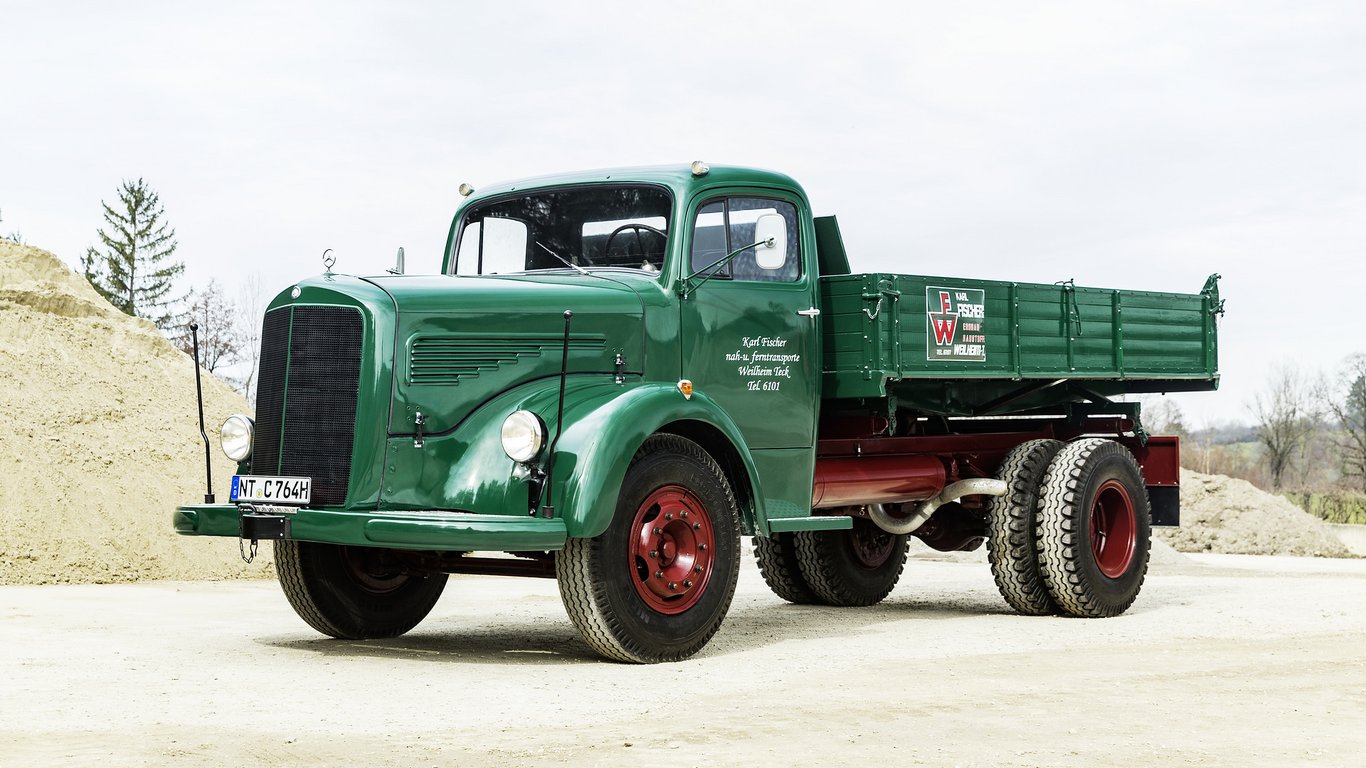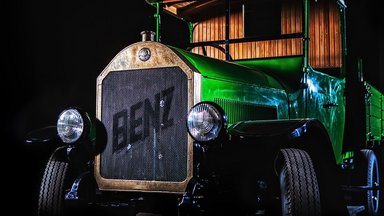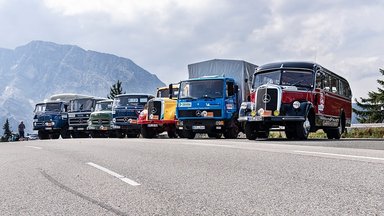
70 years ago: Premiere of the Mercedes-Benz L 6600 heavy-duty truck and O 6600 bus
Download

70 years ago: Premiere of the Mercedes-Benz L 6600 heavy-duty truck and O 6600 bus
The successful models for logistics and travel in the “economic miracle” debuted in 1950 The L 6600 shaped development from short-nosed to cab-over truck O 6600 bus for city, rural transport and long-distance haulage Convincing vehicles and a strong service network inspire customers Stuttgart. Reconstruction, economic miracle and a new desire for travel: the Mercedes-Benz L 6600 heavy-duty truck and the Mercedes-Benz O 6600…
- The successful models for logistics and travel in the “economic miracle” debuted in 1950
- The L 6600 shaped development from short-nosed to cab-over truck
- O 6600 bus for city, rural transport and long-distance haulage
- Convincing vehicles and a strong service network inspire customers
Stuttgart. Reconstruction, economic miracle and a new desire for travel: the Mercedes-Benz L 6600 heavy-duty truck and the Mercedes-Benz O 6600 bus, equipped with the same drivetrain, were the ideal vehicles for all this and more from 1950 right into the mid-1960s. The 304 model series truck was launched on the market in October 1950. The bus followed in November the same year. Both were also exported right from the start. The truck in particular was one of the most important success products for the rise of what was then Daimler-Benz AG into a globally operating commercial vehicle manufacturer. This chapter in the history of the companyʼs commercial vehicles began back in 1949 with the presentation of the 312 medium-duty truck series.
Not only the concept of the L 6600 inspired customers, but also the Mercedes-Benz service that came with it: after the end of the Second World War the brand pursued a product and service strategy in the commercial vehicles sector that was based on robust and affordable vehicles with a good kerb weight/payload ratio as well as on a tight-knit service network. This approach was extraordinarily successful. By 1956 commercial vehicles were already generating more than half of Daimler-Benzʼs sales. In the case of the L 6600, the tight-knit service network and fast provision of replacement parts also formed an important competitive advantage for heavy-duty trucks. This applied not only to the German market, but was equally important for exports.
Higher engine output with lower consumption
As a short-nosed truck with 6.6 tonnes payload, at first glance the design of the L 6600 is reminiscent of the commercial vehicles from before the Second World War such as the L 6500 (54 model series). Yet the technology had developed a great deal since 1950 – this applied in particular to the lighter, higher speed diesel engine with increased output and lower consumption. This new technological approach becomes clear when a comparison is drawn between the L 6600 with its OM 315 engine (8,280 cubic centimetres of displacement) and the L 6500 with its OM 57 engine (11,200 cubic centimetres of displacement): the new heavy-duty truck produced 107 kW (145 hp) at 2,100 rpm instead of 110 kW (150 hp) at 1,700 rpm. And while the top speed increased from 55 km/h to 70 km/h, the consumption fell from 36 litres of diesel per 100 kilometres to 24 litres.
The then head of development, Prof. Fritz Nallinger, called the development of the new six-cylinder engine for the L 6600 “definitely a very big step” when looking back in 1965. In as early as 1941, during the Second World War, Mercedes-Benz was already developing and testing the six-cylinder OM 304 diesel engine with a higher engine speed. After 1945 the development into the production-ready OM 315 followed in the engine construction in Untertürkheim. With 40,207 engines built from 1950 until 1979, including replacement and stationary engines, the OM 315 was particularly successful in its class for decades. Alongside the standard OM 315, there was also the OM 315 V multi-fuel engine (81 kW/110 hp) in the military truck LG 315, built according to NATO requirements, the 92 kW (125 hp) OM 315 II for export vehicles as well as the charged OM 315 A with 132 kW (180 hp) for special-purpose vehicles and stationary applications.
Otto Hartmann, who would later become head of diesel engine construction for commercial vehicles, remembered how the engineers used stationary head injection with a glass burner and a perforation at the end of the glass to almost achieve the consumption values of engines by other manufacturers with direct injection. The stationary head injection was distinguished by its improved noise characteristics. This included the oscillating engine mountings in rubber pads with torque support – allowing the L 6600 to attain an engine operation that trade magazine “Last-Auto und Omnibus” praised in the 4/1951 issue: “The smooth running and lack of vibrations of the engine were a pleasant surprise.”
Customer requirements fulfilled
In a 1952 survey by trade magazine “Last-Auto und Omnibus”, 21 customers with a total of 47 vehicles and a mileage already as high as 330,000 kilometres were very satisfied with the L 6600. The assessment of the noise characteristics ranged from very good to entirely satisfactory. The conclusion of the survey went so far as to say: “The experiences with the Mercedes L 6600 were so good that every [owner and driver] would give it serious consideration or buy the same vehicle again in this class.”
While the listed strengths included the smooth ride, the high degree of reliability, the low frequency of repairs, the good performance of the engine, the easy steering and the brakes, there was also criticism of the narrow cab. This was identical to the cab of the L 3500 (L 311) and L 4500 (L 312) medium-duty trucks and was therefore not considered sufficient for long-distance haulage. Therefore, for long-distance haulage, the L 6600 was often equipped with cabs by body manufacturers such as Eylert, Kässbohrer and Wackenhut.
Pioneer of the cab-over
The 304 truck series also stands for the switch from the classic, short-nosed truck of the heavy class to the cab-over heavy-duty truck at Mercedes-Benz. This design makes the commercial vehicle significantly more compact – while maintaining the same transport capacity. By comparison, an L 6600 (called an L 315 from autumn 1954) with a platform length of 6,000 millimetres had a total length of 9,280 millimetres. By contrast, the LP 315 cab-over version, produced initially from May 1954 exclusively for export markets and then also for the German market from 1955, had a total length of just 8,450 millimetres with the same platform length and was accordingly more agile.
In the LP designation for the cab-over, the P stands for “Pullman” due to what was for the time a particularly comfortable cab design, with berths for two people. This cab was produced by Gebrüder Wackenhut GmbH, a body and vehicle factory in Nagold, and was delivered to Gaggenau for final assembly. “Das Nutzfahrzeug” wrote in its 1/1956 issue: “The cab of the LP 315 is something special, which justifiably bears the ʻPullmanʼ version designation. Up to five people can sit on two rows of seats (admittedly with a standalone driverʼs seat). The reverse bench seat can be transformed into two overlying berths. The driverʼs seat can be adjusted in every direction. Despite the exceptionally quiet engine, the rest is taken care of by the additional sound insulation.”
In long-distance haulage in particular, the LP 315 convinced customers, including those on the German market, right from the start. The LP abbreviation was used by Mercedes-Benz for many years in the model designation of cab-over trucks. The versions in the 304 model series were in particular demand due to the legal requirements for limited truck/trailer combination lengths in Germany. The heavy trucks of this generation therefore played an important role in the evolution of short-nosed vehicles to cab-overs.
Great model variety for almost any use
During the production period of the L 6600/L 315, the 304 model series offered a great variety of various configurations and vehicle models with platform vehicles, dump trucks, tractor units and special-purpose vehicles – with various wheelbases and many with all-wheel drive upon request. The switch of model designation took place in 1954 and stood for a new system: previously the designation of models referred to their payload – the L 6600 referred to 6.6 tonnes. Now the abbreviation was derived from the internal model series designation. However, this was not the case for heavy-duty trucks, as from autumn 1954 they were not called L 304, but instead L 315 – the number combination relates to the engine.
The short-nosed trucks were available as platform vehicles (L 6600/L 315), dump trucks (L 6600 K/LK 315) and tractor units (L 6600 Sa/LS 315 – exclusively for export) as well as the LA 315, LAK 315 and LA 6600 Sa/LAS 315 all-wheel drive versions. There was also the LG 315 military truck, which was predominantly delivered to the German Armed Forces. The cab-over trucks of the 304 model series were offered by Mercedes-Benz as the LP 315 platform vehicle, LPK 315 dump truck and LPS 315 tractor unit, also with various wheelbases. Of this generation of heavy-duty truck, 13,735 vehicles were produced as a classic short-nosed truck with rear-axle drive (1950 to 1958), 1,264 as all-wheel versions (1954 to 1957), 2,480 as cab-overs (1954 to 1957) and 8,283 as military trucks (1956 to 1964). In total 25,762 vehicles were produced.
A bus for travel and regular services in the city and the countryside
The 304 model series also included the Mercedes-Benz O 6600 buses. This model was created by combining the elegant new bus bodies of the late 1940s (O 5000) with the drivetrain and the six-speed transmission of the new L 6600 heavy-duty truck. The O 6600 was available ex factory as a city bus (two sliding doors, 27 or 29 seats and standing room for 14 in the vehicle interior as well as on the rear platform), intercity bus (folding or sliding door on the right side of the vehicle, 37 or 41 passenger seats, depending on the number of rows of seats, as well as 8 or 9 folding seats in the aisle and a two-person folding seat alongside the driver upon request) and as an all-weather touring coach (additionally including Webasto sliding sunroof and glazing around the edge of the roof). From 1954 it was called the O 304. Between July 1950 and January 1959, 625 vehicles were built in the various design and equipment lines and as chassis cabs.
The press reaction to the O 6600 was positive. In the 4/1951 issue, “Omnibus-Revue” praised the elasticity and conspicuously smooth ride of the engine as well as a top speed limited to 88.8 km/h, which was high for its time. Regarding the suspension, the testers wrote: “On roads with deep potholes no unpleasant jolts were noticeable in any of the seats. It felt as if we were travelling in a good car.” “Last-Auto und Omnibus” concluded in the 11/1951 issue: “In terms of the engine, chassis, handling and standard assembly, the Mercedes-Benz O 6600 is one of the most economical, fast and comfortable touring coaches. The chassis allows for superstructures of any kind. The output of the engine is sufficient to practically get by with the top four gears even at full payload.”
Daimler-Benz took a two-pronged approach during the early 1950s in the development of cab-over buses with the OM 315 diesel engine: the O 6600 H/O 320 H of the 320 model series, which was built from March 1951, followed the modern design of the rear-engine bus. Parallel to this, however, there was also a more affordable cab-over chassis with the engine at the front. This OP 6600/OP 315 with a wheelbase of 5,700 millimetres was built from December 1953 and fitted by renowned body manufacturers, such as Vetter in Fellbach. A Mercedes-Benz press release from July 1955 had this to say about the model: “After the comprehensive bus order by the City of Tehran, Daimler-Benz A.G. has now also been able to conclude a major bus delivery for the City of Istanbul. Istanbul will receive 200 Mercedes-Benz buses of the OP 315 model, a further development of the O 6600 in the Pullman design.” The O 6600 T was used in many cities around the world as an electric trolley bus with overhead cables.
Article assets

70 years ago: Premiere of the Mercedes-Benz L 6600 heavy-duty truck and O 6600 bus

70 years ago: Premiere of the Mercedes-Benz L 6600 heavy-duty truck and O 6600 bus

Mercedes-Benz LA 315, LAS 315 and LAS 315. Brochure from July 1954.

70 years ago: Premiere of the Mercedes-Benz L 6600 heavy-duty truck and O 6600 bus

70 years ago: Premiere of the Mercedes-Benz L 6600 heavy-duty truck and O 6600 bus

70 years ago: Premiere of the Mercedes-Benz L 6600 heavy-duty truck and O 6600 bus

70 years ago: Premiere of the Mercedes-Benz L 6600 heavy-duty truck and O 6600 bus

70 years ago: Premiere of the Mercedes-Benz L 6600 heavy-duty truck and O 6600 bus

70 years ago: Premiere of the Mercedes-Benz L 6600 heavy-duty truck and O 6600 bus

70 years ago: Premiere of the Mercedes-Benz L 6600 heavy-duty truck and O 6600 bus

70 years ago: Premiere of the Mercedes-Benz L 6600 heavy-duty truck and O 6600 bus

70 years ago: Premiere of the Mercedes-Benz L 6600 heavy-duty truck and O 6600 bus

70 years ago: Premiere of the Mercedes-Benz L 6600 heavy-duty truck and O 6600 bus

70 years ago: Premiere of the Mercedes-Benz L 6600 heavy-duty truck and O 6600 bus

70 years ago: Premiere of the Mercedes-Benz L 6600 heavy-duty truck and O 6600 bus

70 years ago: Premiere of the Mercedes-Benz L 6600 heavy-duty truck and O 6600 bus

70 years ago: Premiere of the Mercedes-Benz L 6600 heavy-duty truck and O 6600 bus

70 years ago: Premiere of the Mercedes-Benz L 6600 heavy-duty truck and O 6600 bus

70 years ago: Premiere of the Mercedes-Benz L 6600 heavy-duty truck and O 6600 bus

70 years ago: Premiere of the Mercedes-Benz L 6600 heavy-duty truck and O 6600 bus

70 years ago: Premiere of the Mercedes-Benz L 6600 heavy-duty truck and O 6600 bus

70 years ago: Premiere of the Mercedes-Benz L 6600 heavy-duty truck and O 6600 bus

70 years ago: Premiere of the Mercedes-Benz L 6600 heavy-duty truck and O 6600 bus

70 years ago: Premiere of the Mercedes-Benz L 6600 heavy-duty truck and O 6600 bus

70 years ago: Premiere of the Mercedes-Benz L 6600 heavy-duty truck and O 6600 bus

70 years ago: Premiere of the Mercedes-Benz L 6600 heavy-duty truck and O 6600 bus

70 years ago: Premiere of the Mercedes-Benz L 6600 heavy-duty truck and O 6600 bus

70 years ago: Premiere of the Mercedes-Benz L 6600 heavy-duty truck and O 6600 bus

70 years ago: Premiere of the Mercedes-Benz L 6600 heavy-duty truck and O 6600 bus

70 years ago: Premiere of the Mercedes-Benz L 6600 heavy-duty truck and O 6600 bus

70 years ago: Premiere of the Mercedes-Benz L 6600 heavy-duty truck and O 6600 bus

70 years ago: Premiere of the Mercedes-Benz L 6600 heavy-duty truck and O 6600 bus

70 years ago: Premiere of the Mercedes-Benz L 6600 heavy-duty truck and O 6600 bus

70 years ago: Premiere of the Mercedes-Benz L 6600 heavy-duty truck and O 6600 bus

70 years ago: Premiere of the Mercedes-Benz L 6600 heavy-duty truck and O 6600 bus

70 years ago: Premiere of the Mercedes-Benz L 6600 heavy-duty truck and O 6600 bus

70 years ago: Premiere of the Mercedes-Benz L 6600 heavy-duty truck and O 6600 bus

70 years ago: Premiere of the Mercedes-Benz L 6600 heavy-duty truck and O 6600 bus

70 years ago: Premiere of the Mercedes-Benz L 6600 heavy-duty truck and O 6600 bus

70 years ago: Premiere of the Mercedes-Benz L 6600 heavy-duty truck and O 6600 bus

70 years ago: Premiere of the Mercedes-Benz L 6600 heavy-duty truck and O 6600 bus

70 years ago: Premiere of the Mercedes-Benz L 6600 heavy-duty truck and O 6600 bus

70 years ago: Premiere of the Mercedes-Benz L 6600 heavy-duty truck and O 6600 bus

70 years ago: Premiere of the Mercedes-Benz L 6600 heavy-duty truck and O 6600 bus

70 years ago: Premiere of the Mercedes-Benz L 6600 heavy-duty truck and O 6600 bus

70 years ago: Premiere of the Mercedes-Benz L 6600 heavy-duty truck and O 6600 bus

70 years ago: Premiere of the Mercedes-Benz L 6600 heavy-duty truck and O 6600 bus

70 years ago: Premiere of the Mercedes-Benz L 6600 heavy-duty truck and O 6600 bus

70 years ago: Premiere of the Mercedes-Benz L 6600 heavy-duty truck and O 6600 bus

70 years ago: Premiere of the Mercedes-Benz L 6600 heavy-duty truck and O 6600 bus

70 years ago: Premiere of the Mercedes-Benz L 6600 heavy-duty truck and O 6600 bus

70 years ago: Premiere of the Mercedes-Benz L 6600 heavy-duty truck and O 6600 bus

70 years ago: Premiere of the Mercedes-Benz L 6600 heavy-duty truck and O 6600 bus

70 years ago: Premiere of the Mercedes-Benz L 6600 heavy-duty truck and O 6600 bus

70 years ago: Premiere of the Mercedes-Benz L 6600 heavy-duty truck and O 6600 bus

70 years ago: Premiere of the Mercedes-Benz L 6600 heavy-duty truck and O 6600 bus

70 years ago: Premiere of the Mercedes-Benz L 6600 heavy-duty truck and O 6600 bus

70 years ago: Premiere of the Mercedes-Benz L 6600 heavy-duty truck and O 6600 bus

70 years ago: Premiere of the Mercedes-Benz L 6600 heavy-duty truck and O 6600 bus

70 years ago: Premiere of the Mercedes-Benz L 6600 heavy-duty truck and O 6600 bus

70 years ago: Premiere of the Mercedes-Benz L 6600 heavy-duty truck and O 6600 bus

70 years ago: Premiere of the Mercedes-Benz L 6600 heavy-duty truck and O 6600 bus

70 years ago: Premiere of the Mercedes-Benz L 6600 heavy-duty truck and O 6600 bus

70 years ago: Premiere of the Mercedes-Benz L 6600 heavy-duty truck and O 6600 bus

Mercedes-Benz L 315. Brochure from June 1954.

Mercedes-Benz L 6600. Brochure from February 1951.



































































